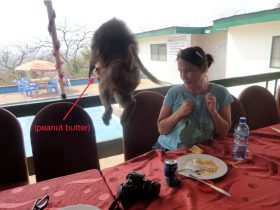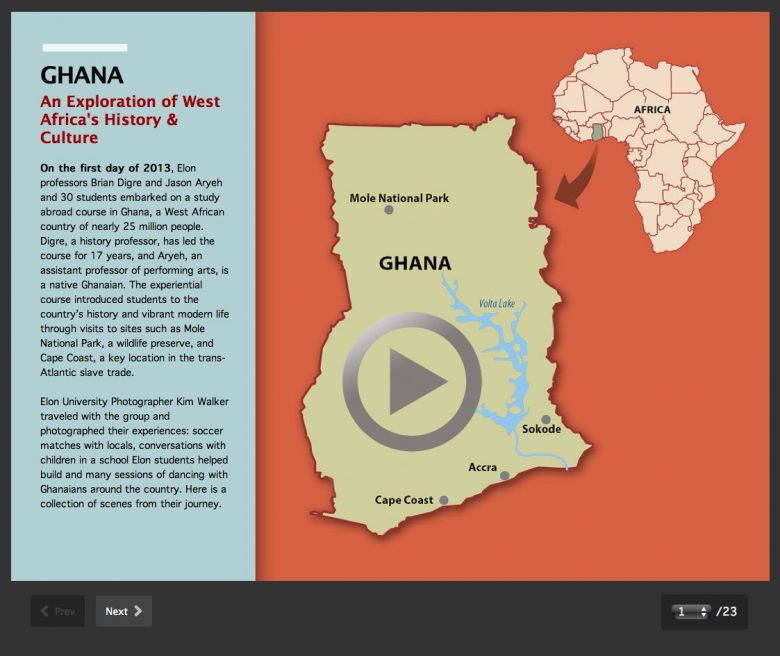Browse this photo slideshow and experience Ghana through the lens of Elon University Photographer Kim Walker, who visited the West African country as part of a Winter Term course.
By Kim Walker
Only a few hours after ringing in 2013, I wheeled my 30-pound bag of photo gear through Raleigh-Durham International Airport onto a flight bound for Ghana via London. I found the 30 Elon students—along with Professor of History Brian Digre and Assistant Professor of Performing Arts Jason Aryeh—in various states of awake at the London airport and joined them for the last leg of the voyage to Ghana.
We landed in Accra, Ghana’s capital, around 9 p.m., exhausted but enthusiastic. Following a full night’s sleep, we ventured east to the Volta Region and into Sokode, which offered students a speedy immersion into a very different, yet friendly culture.
The first order of business was a Durbar, a welcome celebration attended by most of Sokode’s residents. It featured local speakers, musicians and the first of many dance sessions students would encounter during their visit. Not even the shyest of students were left sitting in their chairs once the Ghanaians began to pull them into the circle to dance; participation was non-negotiable.
 The Durbar revealed a side of Digre the students had never witnessed: his role as Ngoryfia, or development chief, an honor he received in 2004. He was dressed from head to toe in native clothing, including a headpiece, jewelry, robes and traditional sandals. Digre walked with Sokode’s chief as they led a procession of elders and citizens through the street and into the gathering space for the Durbar.
The Durbar revealed a side of Digre the students had never witnessed: his role as Ngoryfia, or development chief, an honor he received in 2004. He was dressed from head to toe in native clothing, including a headpiece, jewelry, robes and traditional sandals. Digre walked with Sokode’s chief as they led a procession of elders and citizens through the street and into the gathering space for the Durbar.
Elon students participating in this year’s course continued the tradition of bringing school supplies and funds to the village. Further strengthening the Elon-Sokode bond, they capped off their visit to Sokode with an impromptu soccer match. Laughing and running with students dressed in their dark green uniforms, they zigzagged in front of the school Elon helped to build.
Afterward, they climbed into the familiar blue and silver bus, sweaty and tired, and headed back to Accra, in southern Ghana. In the capital, they attended classes led by local professors and spent some time exploring the city. Aryeh is from Accra, and his parents hosted our group for an evening party. The dance troupe with which Aryeh worked when he was living in Accra performed, and his mother and extended family prepared an enormous buffet. The night ended with a dance party, fueled by a local DJ.
Because I was leaving Ghana a bit earlier than the rest of the group, I spent a day with a local videographer, Qwaku Asamoah, visiting some of the sights on the southern coast of Ghana that the students would explore later. We wobbled across the swinging walkways among the treetops of Kakum National Park and toured Cape Coast Castle, where slaves were kept and auctioned during the time of the trans-Atlantic slave trade. The small wooden door leading from the castle’s interior out to the beach where the slaves were loaded onto ships is intact. But a walk through that infamous passage today reveals a beach full of color, noise and activity. Lining the water are gaudy wooden boats and fishermen shouting to one another as they mend their bright green nets. The juxtaposition of a tragic history and a vivacious present is striking.
 From Accra, we spent a day on the bus, bumping over red dirt roads toward the Northern Region for a stay in Mole National Park. The park, Ghana’s largest wildlife refuge, houses more than 400 animal species. The elephants were decidedly the stars, and the students spotted many of them as well as baboons, warthogs, antelopes, birds and reptiles during a morning hike through the countryside. I had a personal experience with the native wildlife when a baboon leapt onto the table during lunch and snatched my beloved jar of peanut butter right out of my hands. Though I hated to see my American comfort food carried away, I was grateful that I survived the encounter fully intact. Baboons have huge fangs and cranky temperaments.
From Accra, we spent a day on the bus, bumping over red dirt roads toward the Northern Region for a stay in Mole National Park. The park, Ghana’s largest wildlife refuge, houses more than 400 animal species. The elephants were decidedly the stars, and the students spotted many of them as well as baboons, warthogs, antelopes, birds and reptiles during a morning hike through the countryside. I had a personal experience with the native wildlife when a baboon leapt onto the table during lunch and snatched my beloved jar of peanut butter right out of my hands. Though I hated to see my American comfort food carried away, I was grateful that I survived the encounter fully intact. Baboons have huge fangs and cranky temperaments.
Following a day trip to the nearby community of Mognori, a rural village inhabited by both Muslims and Christians, the students spent their last evening in Mole playing soccer with the residents as the sun set. The next morning, we bid the preserve goodbye and hit the dusty road back south.
My time in Ghana came to a close in Kumasi, our next destination, but the rest of the group stayed for another week, taking in some of the historical sights of Kumasi and a few days on the coast. As our Ghanaian travel companion, George, helped me load my bags into the trunk of an old taxi for the trip to the airport, I savored the honking horns, hazy air and crowded streets. I hated to leave, but I brought back thousands of images. Digre beaming from beneath a huge red umbrella as he entered the Durbar. Gloria So asking a Ghanaian weaver to give her a lesson. Students shrieking as they stood under the frigid Wli Falls. The tearful eyes of Aryeh’s mother as she welcomed him back home.
Sharing my work with my new friends from the 2013 Ghana course as well as the students, faculty, staff and alumni who may encounter it, keeps those moments I experienced and documented alive. What more could a photographer ask for?
Click here to see the photo slideshow. To read the story about the course that appeared in the summer edition of The Magazine of Elon, click here.



